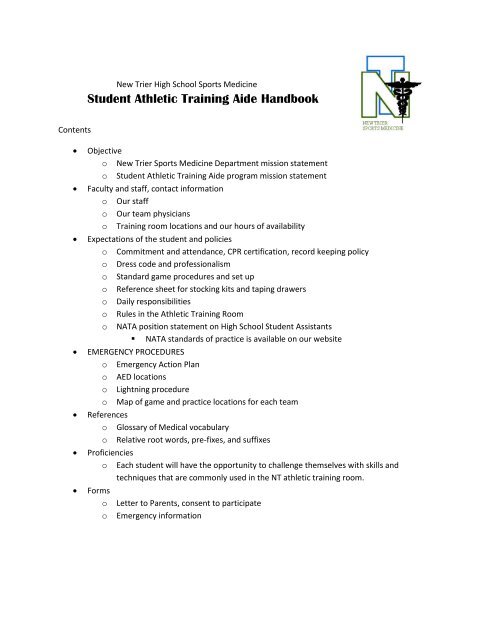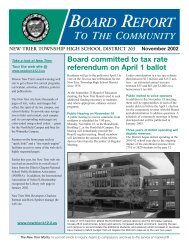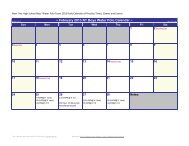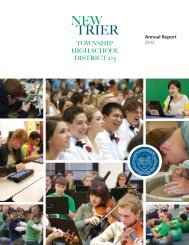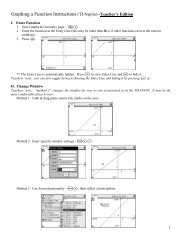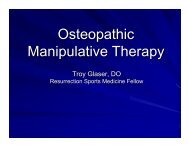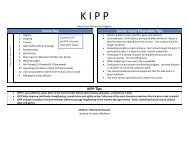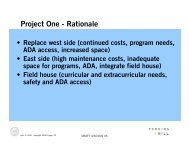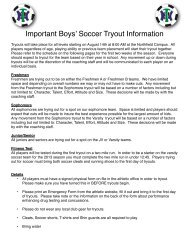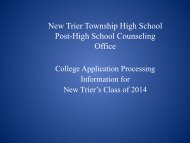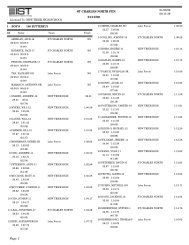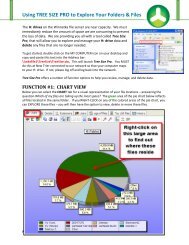Student Handbook - New Trier Township High School
Student Handbook - New Trier Township High School
Student Handbook - New Trier Township High School
You also want an ePaper? Increase the reach of your titles
YUMPU automatically turns print PDFs into web optimized ePapers that Google loves.
<strong>New</strong> <strong>Trier</strong> <strong>High</strong> <strong>School</strong> Sports Medicine<strong>Student</strong> Athletic Training Aide <strong>Handbook</strong>ContentsObjectiveo <strong>New</strong> <strong>Trier</strong> Sports Medicine Department mission statemento <strong>Student</strong> Athletic Training Aide program mission statementFaculty and staff, contact informationo Our staffo Our team physicianso Training room locations and our hours of availabilityExpectations of the student and policieso Commitment and attendance, CPR certification, record keeping policyo Dress code and professionalismo Standard game procedures and set upo Reference sheet for stocking kits and taping drawerso Daily responsibilitieso Rules in the Athletic Training Roomo NATA position statement on <strong>High</strong> <strong>School</strong> <strong>Student</strong> Assistants• NATA standards of practice is available on our websiteEMERGENCY PROCEDURESo Emergency Action Plano AED locationso Lightning procedureo Map of game and practice locations for each teamReferenceso Glossary of Medical vocabularyo Relative root words, pre-fixes, and suffixesProficiencieso Each student will have the opportunity to challenge themselves with skills andtechniques that are commonly used in the NT athletic training room.FormsooLetter to Parents, consent to participateEmergency information
<strong>New</strong> <strong>Trier</strong> Sports Medicine StaffDale Grooms, ATC(847) 784-2297groomsd@newtrier.k12.il.usPatty McClintock, ATC(847) 784-7750mcclintp@newtrier.k12.il.usKristin Romani, ATC(847) 784-6601romanik@newtrier.k12.il.usDanah Ouimette, MA.Ed, ATC(847) 784-7739ouimettd@newtrier.k12.il.usAffiliated PhysiciansRichard Sherman, M.D.Illinois Bone and Joint Institute, LLC.Winnetka campus – southeast corner of field house(847) 784-2299385 Winnetka AveWinnetka, IL 60093Northfield Campus –F building, 1 st floor(847) 784-22997 Happ RoadNorthfield, IL 60093Main FacilitiesDuke Childs fields, Neilson Tennis Center, Fox Meadow fields and Winnetka Park District softball fieldsare also used by our athletic program and a certified athletic trainer will be available at these locationsduring events and most practices.<strong>School</strong> year hours:Athletic Trainers will be available on normal school days at both campuses from 10:00am through theend of practices (6:30pm) or until the conclusion of all competitions. On Saturdays and holidays, athletictrainers will be available from 8:00am until 12:00pm and during any scheduled competition. An athletictrainer will be at Duke Childs and/or Fox Meadow locations during scheduled practices and competitionsto the best of our ability.Summer hours:Athletic trainers will be available on each campus during summer school from 8:00am until 12:00pmMonday through Friday.
Expectations of the <strong>Student</strong> AideA student wishing to be a part of this program must read through this handbook and sign thecommitment along with a parent or guardian.<strong>Student</strong> aides are expected to commit to 3 days per week after school, during lunch or aSaturday. This must include at least one scheduled competition (exceptions may apply due toclass schedules). Saturdays are expected at least twice each month (as 1 of the 3 days/week). Asignup calendar is located on the student board in the athletic training room and schedules mustbe made at least one week in advance by the student aides on a first come first serve basis.Once monthly, mandatory meetings will be held for skills games/competitions as well aseducation. This time will be also be used for other necessary business (and most likely willinclude tasty treats.)There will be a CSL <strong>Student</strong> AT Aide Summit in late spring. This will include a knowledge bowlbetween participating high school programs and possibly a seminar or educational component.<strong>Student</strong> aides are expected to be on time after school on days committed, ten minutes after thebell, and will be dressed appropriately (see dress code policy) and ready to work in aprofessional manner. <strong>Student</strong> aides must stay until the end of practice (no later than 6:30pm)or the end of a game to which they have committed themselves. If a game lasts later than8:30pm, the student aide may be dismissed early.If a student is going to miss a commitment, they must call the certified athletic trainer before3:00pm (7:30am on Saturdays). The student must commit to an additional practice within oneweek. If no call is made, the student is unexcused and must commit to 2 additional practiceswithin the week.Academics will always come first. If a student aide is unable to maintain a minimum C grade inall classes, the student aide will be dismissed from athletic training for three weeks or untilgrades are improved.A student aide will be excused from athletic training commitment if they are an in-seasonathlete. During this time, the student will not be acting as a student aide and if they are in theathletic training room for personal reasons, they are not allowed to perform any athletictraining responsibilities.<strong>Student</strong> aides take part in the daily and weekly responsibilities and check them off the list on thestudent board.<strong>Student</strong> aides will complete the proficiencies included later in this handbook. <strong>Student</strong> aides willonly be allowed to practice these skills on athletes once they have been approved by thecertified athletic trainer.It is imperative that all treatment logs and injury reports are thorough and kept up to date.Occasionally, an ATC will oversee treatment performed by a student aide and the student aidemay complete the record entry. <strong>Student</strong> aides are not to modify any athlete’s treatment orrehab or do an initial evaluation on an athlete without a certified athletic trainer’s permission,instruction, AND this may only be done once the record keeping skill has been completed in theproficiencies packet.<strong>Student</strong> aides will abide by and enforce all Athletic Training Room rules and behave in aprofessional manner. Remember, you are representing the entire <strong>New</strong> <strong>Trier</strong> <strong>High</strong> <strong>School</strong> SportsMedicine department.<strong>Student</strong> aides must maintain current CPR/AED certification. This will be provided by the SportsMedicine staff. A copy of the card will be kept in the athletic training room. Before this is
completed, a student aide will not be unsupervised on any athletic field for a practice orcompetition.Expectations and education of the student aides are guided by the NATA position statement onproper supervision of <strong>High</strong> <strong>School</strong> Athletic Training <strong>Student</strong> Aides (see attached document).Dress Code/Appearance for <strong>Student</strong> AidesAs a student athletic training aide, you are representing the entire <strong>New</strong> <strong>Trier</strong> Sports Medicinedepartment, <strong>New</strong> <strong>Trier</strong> Athletic Department and our team physicians. It is important to be professionaland this includes your attire. In order to identify yourself as a student aide, you need to wear a <strong>New</strong> <strong>Trier</strong> Sports Medicine T-shirt whenever acting as a student aide. If you do not have your t-shirt on when you enter thedoor, you will not be allowed to act as a student aide. Absolutely no skirts or dresses. No flip flops or high heels. You need to be able to run. Hair needs to be kept neat and pulled back in a functional manner. No tank tops (you should be wearing your t-shirt anyway). No ripped jeans or khakis. Absolutely no jeans for competitions. Khaki pants or shorts. Weather appropriate clothing willbe allowed. No short shorts. If you think they might be too short, they are. Finger nails need to be kept neat, clean and no longer than the tip of your finger. No dangly jewelry that can get caught or in the way.Other guidelines for professional behaviorNo use of cell phones in the athletic training room or on the field. Pay attention.Address physicians, coaches, athletic directors, and officials respectfully. No first names.Keep the gossip to a minimum.All medical information is confidential and may not be discussed with anyone outside of thesports medicine staff under any circumstances.
NATIONAL ATHLETIC TRAINERS’ ASSOCIATION:OFFICIAL STATEMENT ON PROPER SUPERVISION OF HIGH SCHOOL ATHLETIC TRAININGSTUDENT AIDESIntroduction:This Official Statement of the National Athletic Trainers’ Association provides supportand guidance to school administrators and athletic trainers in the education andsupervision of high school students enrolled in sports medicine courses or participating inhigh school athletic training programs. The goal of this statement is to continue to fostera positive, safe learning environment where students benefit from the instruction ofqualified health care professionals.Official Statement:The NATA recognizes that allowing high school students the opportunity to observe thedaily professional duties and responsibilities of an athletic trainer can be a valuableeducational experience. This unique experience may expose students to thefoundations of various health related careers as well as provide them with important lifeskills. Regardless of practice setting, it is understood that all athletic trainers must complywith their state practice act, BOC Standards of Practice when certified, and Code ofEthics when a member of NATA. These legal and ethical parameters apply whenincorporating student aides outside of the classroom and within the activities of athleticprograms.<strong>Student</strong> aides must be under the direct visual supervision of a licensed/certified athletictrainer when assisting with any athletic training services. Coaches and schooladministrators must not allow or expect student aides to act independently with regardsto the evaluation, assessment, treatment and rehabilitation of injuries. Additionally, it isparamount that student aides not be expected, asked or permitted to make “return toplay” decisions. Specifically, student aides must not engage in the following activities:(1) Interpreting referrals from other healthcare providers(2) Performing evaluations(3) Making decisions about treatments, procedures or activities(4) Planning patient care(5) Independently providing athletic training services during team travel.National Athletic Trainers’ Association 3/09/10
Supplies and Med KitsPart of the responsibility of the student aides is to help maintain fully stocked taping drawers and helpwith distributing travel med kits for each team. This is intended to help familiarize students with thedifferent types of medical supplies used in the athletic training room. Each student will also have a smallkit of their own to carry on the field and it is their responsibility to keep this stocked. A certified athletictrainer will go over these supplies with all students at the beginning of the year. <strong>Student</strong>s may use thislist as a guide.TAPING DRAWERS 1 ½” linen tape 2” lightplast stretch 3” lightplast stretch 3” Elastikon ½” lightplast stretch STA tape adherent Heel and lace pads Pre-wrap SuperPro scissorsPERSONAL KIT Gloves Gauze Bandaid assortment, non-adherent pads Bacitracin foil packets Hydrogen peroxide Stiptik sticks (blood clotting agent) Mastisol (adhesive aid) Steri-strips Noseplugs Scissors Cotton tipped applicators 1 ½” linen tape 2 or 3” stretch tape Pre-wrap Sam Splint Ice bags (handy for multiple uses) Medium sized Ace wrap Purel or alcohol sanitizing wipesTRAVEL MED KITS Gloves Gauze Bandaid assortment, non-adherent pads Bacitracin foil packets Pre-wrap 1 ½” linen tape 2 or 3” stretch tape Noseplugs Purel or alcohol sanitizing wipes Small ace wrap Mouthguards (sport specific)
Set up for Game DaysGame day procedures will always be subject to change depending on number of games, numberof teams, and weather conditions. Always check with an ATC to modify if necessary. The following is alist of common water setups at our main campuses that are least likely to change. In addition to thewater and ice, a radio will always be placed at the scorer’s table or given to the head coach. If an ATC orstudent aide is not going to be present on the field, always make sure that there is a med kit availablefor small cuts and immediate first aid needs.WINNETKABasketball-boys/girls: varsity/soph- (2) 10 gallon coolers of ice water and cups, (2) small blue ice coolersField hockey -(for each field)(2) 7 gallons of ice water, cups, (1) small blue cooler of ice *Lacrosse boys: varsity/jv – (1) waterboy, (2) racks water bottles, (1) 7 gallon of iceSoccer- boys: varsity/soph-(2) 10 gallon of ice water, cups, (1) 7 gallon of ice*Soccer -girls: varsity/soph- (2) 7 gallon of ice water, cups, (1) 7 gallon of ice*Softball-freshman: (2) 3 gallons ice water, (1) blue cooler of ice*Swimming and Diving-(1) small blue cooler of iceTennis- (1) 7 gallon ice water, (1) blue cooler of iceTrack-boys/girls-(1) water boy, (1) 7 gallon ice water, (1) 7 gallon of iceWater Polo: (1) small blue cooler of iceNORTHFIELDFootball: varsity/soph-(2) water boys with ice water, (2) 7 gallon coolers of gatorade, (2) racks of waterbottles, one wheeled chest of ice, (2) 10 gallon coolers of ice water for visitorsfreshmen A-stationary water boy and (2) racks of water bottlesfreshmen B-(1) 10 gallon of ice water and (2) racks of water bottles, (1) 10 gallon of iceBasketball boys/girls: freshmen- (2) 10 gallon coolers of ice water, cups, (1) small blue cooler of iceLacrosse-boys: freshmen- (2) 10 gallons ice water, (2) racks water bottles, (1) 3 gallon of ice*Lacrosse-girls: varsity/jv-(1) 10 gallon ice water, (1) rack water bottles or cups, (1) 3 gallon of iceFreshmen- (2) 7 gallons ice water, cups, (1) blue cooler of ice*Soccer-girls: freshmen-(2) 3 gallons of ice water, (1) 3 gallon of ice*Tennis- (1) 7 gallon ice water, (1) blue cooler of ice*This list includes providing water for the visiting teams which may not always be necessary.
Directions for EMSProvide this information to dispatcher upon requestWINNETKA CAMPUS385 Winnetka Ave, WinnetkaEnter on Essex Ave, east side of schoolTrack field-located on east side of Essex, use the gate at north end of the track.North fields-located north of the school building, use gate at southeast corner of fields on Essex.All Gyms-enter building through main doors, just north of tennis courts.Field house and Athletic Training Room-enter building through ramp entrance on north sideEnter on Woodland Ave, west side of school buildingPool-enter parking lot off Woodland Ave on north side buildingNORTHFIELD CAMPUS7 Happ Road, NorthfieldEnter from Happ RoadStadium field-driveway is on north side of school building, stadium visible from roadPool-use driveway at south end of stadium, continue to ramp entrance, north side of buildingAll Gyms-use main floor entrance on south side of F buildingForest Preserve fields-enter parking lot on south side of school and continue to back of buildingFOX MEADOW FIELDSLocated at Willow and Fox Meadow DriveTurn south from Willow Ave and follow Fox Meadow Drive until soccer fields are visible.DUKE CHILDS FIELDSLocated at Willow and Hibbard RoadBaseball and Lacrosse-use parking lot off Willow AveSoftball-enter driveway from Hibbard Road, north of fieldsTennis-entrance on Hibbard Road, continue to back parking lot on west end of tennis courts
AED LOCATIONSWinnetka: Outside Health Services Room 029 Outside Staff Wellness RoomRoom G204 N17 Doors/M Stairs (nearest to pool) Across from Room 153 Training RoomRoom G002 Wrestling and Dance RoomsOutside G011 Outside G108/109East wall *East Field ShedNear Essex RoadNorthfield: Building D Building F Building A *Northeast Corner of Stadium *Loading Dock at Building B*Duke Childs*Fox MeadowsOutside D119Outside F107Outside A210Bolted to FenceClubhouse Locker RoomEquipment Shed*Stored inside school during winter.
Glossary of Medical TermsAbduction: movement of a body part away from the midline of the bodyAbrasion: a type of open wound from scraping or rubbingAdduction: movement of a body part toward the midline of the bodyAccident: occurring by chance or without intentionAmbulation: move or walk from place to placeAmnesia: loss of memoryAcute: sudden onset and short durationAnorexia: lack or loss of appetite; aversion to eatingAnorexia Nervosa: eating disorder characterized by a distorted body image and aversion to eatingAnterior: before or in front ofAnteroposterior: refers to position or movement of front to backAnxiety: a feeling of uncertainty or apprehensionApophysis: attachment site of muscle to bone, usually a slightly raised outgrowth of boneApophysitis: inflammation at an apophysis caused by repetitive stressArthroscopic: describes viewing the interior of a joint utilizing a small camera lens and a non-invasivesurgical techniqueArticulation: a joint, site where two or more bones move on one anotherAssumption of risk: an individual, through expressed or implied agreement, assumes that some risk ordanger will be involved in a particular undertakingAsymmetry: lack of symmetry, noted difference on one side of the bodyAtrophic Necrosis: death or wasting away of an area of the body due to nerve damageAtrophy: diminution of size; wasting away due to lack of nutrition or nervous stimulationAvascular Necrosis: death of a tissue or bone due to lack of blood supplyAvulsion: tearing away, usually muscle from boneBandage: a strip of cloth or other material used to hold a dressing in placeBilateral: pertaining to both sides of a bodyBiomechanics: branch of study that applies the laws of mechanics and motion to living organism andbiological tissuesBulimia: eating disorder characterized by distorted body image and binge-purge eating habitBursa: a fibrous sac acting as a protective cushion between certain tendons and bone, allowing smoothmovement during muscle patternBursitis: inflammation of a bursa, can be acute or chronicCatastrophic injury: any injury or condition with a potential permanent loss or damage; usually refers tocardiac or spinal injuryChondromalacia: a degeneration of a joint’s articular surface, leading to softeningChronic: long onset and long durationCircumduct: act of moving a limb such as the arm or hip in a circular motionClosed fracture: any fracture that does not penetrate the superficial tissueCommunicable disease: a disease that is transmitted directly or indirectly from one individual toanotherConcentric muscle contraction: contraction of a muscle by shorteningConcussion: a injury to the brain or spinal cord due to jarring from a blow or fallConduction: transfer of temperature thermal energy by direct contact with a mediumContact sport: any sport involving regular physical contact
Contrecoup brain injury: after head is struck, brain continues to move within the skull and becomesinjured on the side opposite the forceContusion: a bruiseConvection: transfer of thermal energy indirectly through another medium such as air or liquidConversion: transfer of thermal energy by other forms of energy such as electricityConvulsion: paroxysm of involuntary muscular contraction and relaxationCrepitation: a crackling sound heard during movement of body part or joint; related to inflammation orfractured boneDebride: remove dirt and dead tissue from a wound; smooth or clean damaged tissueDegeneration: deterioration of tissueDiaphragm: a musculomembranous wall separating the abdomen from the thoracic cavityDiastolic blood pressure: the residual pressure when the heart is relaxed (in between beats)Distal: furthest away from the point of reference or midline of the bodyDorsiflexion: bending toward the dorsum or rear, opposite of plantar flexionDressing: a material, such as gauze, applied to a wound (held in place with a bandage)Duration: length of timeEccentric: muscle contraction by lengthening of the muscleEcchymosis: skin discoloration due to hemorrhageEctopic: located in an abnormal placeEdema: swelling; collection of fluid as resultElectrolyte: solution that is a conductor of electricity; important to proper hydration (i.e. sodium andpotassium)Electrotherapy: treating a disease by electrical devicesEndurance: ability to undergo prolonged physical demandEpiphysis: the cartilaginous growth region of a boneEtiology: pertaining to the cause or origin of a conditionEversion: (of the ankle) to abduct the foot, stressing medial tissues of the ankleFascia: fibrous membrane that covers, supports, and separates musclesFasciitis: inflammation of the fasciaFrequency: number of times (i.e. twice per week)Genu recurvatus: hyperextension of the kneeGenu valgum: knock kneesGenu varum: bow legsHeat exhaustion: a condition characterized by faintness, rapid pulse, nausea, profuse sweating, coolskin, and collapse, caused by prolonged exposure to heat accompanied by loss of adequate fluid and saltfrom the bodyHeat stroke: a disturbance of the temperature-regulating mechanisms of the body caused byoverexposure to excessive heat, resulting in fever, hot and dry skin, and rapid pulse, sometimesprogressing to delirium and comaHematoma: blood tumor or massHemoglobin: oxygen carrying pigment of red blood cells; give blood its red colorHemophilia: a hereditary blood disease in which coagulation is greatly prolongedHemorrhage: discharge of bloodHemothorax: bloody fluid in the pleural cavityHyperextension: stretching of a joint beyond its normal extensionHyperflexibility: soft tissue flexibility beyond a joint’s normal range without forceHypermobility: mobility or instability of a joint involving insufficient soft tissue or bony supportHyperthermia: abnormally high body temperature
Hypertension: high blood pressure; abnormally high tensionHypertrophy: enlargement of a tissue caused by increased cell sizeHyperventilation: abnormally rapid and deep breathing that cannot be controlled; causes a decrease incarbon dioxide, fall in blood pressure and faintingHypoallergenic: produces lower amount of allergensHypotension: low blood pressureHypothermia: abnormally low body temperatureHypoxia: lack of an adequate amount of oxygenInjury: an action that causes damage or painInnervation: nerve distribution throughout a body partIntensity: magnitude of energy or force; workloadInterosseous membrane: connective tissue membrane between two parallel bonesIntervertebral: between two vertebraeIntramuscular bleeding: bleeding within a muscleIntravenous: describes a method of administering substances via a veinInversion: (of the foot and ankle) adduction of the foot stressing the tissues on the lateral side of theankleIschemia: local anemiaIsokinetic: describes muscle contraction with a resistance depending on the magnitude of force appliedby the athlete and speed remaining constantIsometric: describes contraction with no change in muscle lengthIsotonic: describes contraction that shortens and lengthens the muscleJoint: articulation of two or more bonesJoint capsule: saclike structure that encloses the articulating ends of bones and some related soft tissuestructuresKeloid: an overgrowth of collagenous scar tissueKyphosis: exaggeration of the normal curve of the thoracic spineLaceration: a rough, jagged tear of the skinLateral: point of reference away from the saggital midline of the bodyLiability: the legal responsibility to perform an act in a reasonable and prudent mannerLigament: connective tissue with no contractile qualities that connects bone to bone and acts as asupport against excessive joint motionLordosis: Abnormal exaggerated curve of the lumbar spine.Medial: point of reference closest to the saggital midline of the body.Muscle: tissue that, when stimulated, contracts and produces motion around a jointMuscle contracture: abnormal shortening of a muscle in which there is great resistance toward passivestretchMuscular endurance: ability to perform repetitive muscular contractions against some resistanceMuscular strength: maximum force that can be produced by a muscle during a single contractionMusculoskeletal: pertaining to muscles and the skeletonNecrosis: death of tissueNegligence: failure to use ordinary or reasonable care or perform a standard, necessary actionNerve entrapment: a nerve that is compressed between bone or soft tissueNeuroma: a tumor formed of nerve tissueNon-contact sport: any sport that does not place athletes in regular physical contactNystagmus: a constant involuntary movement of the eyeball up and down or back and forthOpen fracture: any fracture that involves penetration of bone through superficial tissues
Orthosis: an appliance or apparatus used to support, align, prevent, or correct deformities, or toimprove function of a movable body partOsgood Schlatter’s Disease: apophysitis at the insertion of the quadriceps tendon on the TibiaPalpate: to use hands or fingers to examineParaplegia: paralysis of lower portion of the body and both legsParathesia: abnormal sensation such as numbness, prickling, tinglingPathology: study of the nature and cause of diseasePeriosteum: fibrous covering of bonePlantarflexion: movement in which the forepart of the foot is depressed relative to the anklePlyometric: (exercise) used in workouts to maximize the stretch-contract reflex of the muscles,increasing speed and agilityPneumothorax: a collapse of a lung due to air in the pleural cavityPosterior: toward the back or rearPower: ability to accelerate a load, depending on the level of strength and velocity of a musclecontractionPrimary assessment: Initial first aid evaluationProne: refers to a position with anterior side facing down; laying on stomachPronate: movement (as with hands or feet) of palmar or plantar side to face posterior or away frommidlineProprioceptive Neuromuscular Facilitation: stretching techniques that involve alternating contractionand passive stretchesProprioceptors: organs within the body that provide the athlete with an awareness of where the body isin spaceProximal: nearest to the point of referenceQuadriplegia: paralysis affecting all four limbsReferred pain: pain that is felt at a point of the body other than the sourceRegeneration: repair, regrowth, or restoration of a part such as tissueResidual: that which remains; often used to describe a permanent condition resulting from an injury ordiseaseRotation: turning around an axis in an angular motionSciatica: inflammatory condition of the sciatic nerve; commonly associated with peripheral nerve rootcompressionScoliosis: a lateral deviation curve of the spineSecondary assessment: follow up examination, more detailedSeizure: sudden attackSever’s Disease: apophysitis at the insertion of the Achilles tendon on the calcaneousSpasm: a sudden, involuntary muscle contractionSpica: a figure-8 formed bracing techniqueSpondylolisthesis: forward slipping of a vertebral bodySpondylolysis: a degeneration of the vertebrae and a defect in the articulating process of the vertebraSprain: a stretch or tear of a ligamentStrain: a stretch or tear of a muscleStatic stretching: passively stretching a muscle by placing it in maximal stretch and maintaining constantstretchStress: the positive and negative forces that can disrupt the body’s normal equilibriumSuperior: point of reference toward the top or above anotherSupine: refers to a position with anterior side facing up; laying on one’s back
Supinate: movement (as with the hand or foot) of palmar or plantar side to face anterior or towardmidlineTendon: connective tissue that attaches muscle to bone; more elastic than ligament but not contractileTendonitis: inflammation of a tendon within a synovial sheathTenosynovitis: inflammation of the synovial sheath around a tendonRoot wordsArthro-jointBio-lifeCardi-heartCephalo-headCerebro-brainCranio-skullDerma-skinGastro-stomachGenu-kneeHem, hemat-bloodHydra-waterMyo-muscleNeuro-nerveOsteo-bonePatho-diseasePed-footPhlebo-veinSeptic-poisonSpondyl-vertebraeSyndes-ligaments and jointsTeno-tendonSuffixesALGIA-painASIS or OSIS-condition, stateASTHENIA-weaknessECTOMY-excision, cutting outEMIA-blood, or its partsESTHESIA-feeling, sensationGENIC-causing, originIT IS-inflamationLOGY-science of, study ofLYSIS-reduction, destructionOSCOPY-to viewPATHY-diseasePENIA-insufficiencyPLEGIA-paralysisPLEGIA-breathingTHERMY-heat, use ofTROPHY-growthULATION-act ofPrefixesA or AN-absence of, withoutAB-away fromAD-to or near, towardAMBI-bothANTE-beforeANTI-againstBI or DI- twoDIS-oppositeDYS-difficult, painfulENDO-withinEPI-on, uponHEMI-halfHYPER-above, excessiveHYPO-belowINTER-betweenINTRA-withinMAL-bad, poorMED-middlePARA-two,PERI-aroundPOLY-manyPOST-afterPRE or PRO-beforePSEUD-falseQUAD-fourSUPRA-aboveTRANS-across
ProficienciesEach student aide will be continually challenged with new skills and responsibility. <strong>Student</strong>s will only beallowed to practice these skills on our athletes once they have completed an acceptable amount ofpractice and displayed knowledge of the skills objective and safety standards. This will be approved by acertified athletic trainer. Following is a list of the skills to be completed at each student’s pace. Eachskill will be detailed and outlined in a separate document.CPR certificationWound care and blood proceduresBlister tapingBuddy tapingCompression wrap with horseshoe for acute ankle sprainsCompression wrapping for strains, quadriceps, hamstring, gastrocnemius/soleusPatellar tendonitis/PFPS tapingArch taping, simpleArch taping, longitudinalShin splints, simpleTurf toe tapingWrist taping for sprainsElbow hyperextensionThumb spicaShoulder spicaAnkle sprainAchilles tendonitisApplication of ice bagApplication and set up for heat packSet up and procedure for ice bathApplication and set up for GamereadyApplication and set up for electric stimulationApplication and set up for ultrasoundDaily treatment log entrySOAP noteHOPS note
Letter to ParentsDear Parent or guardian,We are excited to have your son or daughter as a member of our Sports Medicine Club. We feel this is agreat opportunity for students to gain exposure to a professional health care setting while creating newfriendships and having fun.It is important to us that you are aware of all that your son or daughter will be involved in as a part ofthis club both because we want you to know what a great opportunity it is and because of the afterschool and sometimes late night commitments. It also might be possible for one or two students totravel with us to an away event if they choose to and they have your permission. This will be addressedwhen those opportunities arise. <strong>School</strong> vehicles will be driven to these events and the students willalways be under our direct supervision.Please read through this handbook with your son or daughter and if you have any questions, don’thesitate to call us (847-784-2299). More information about the Sports Med Club is available on thewebsite http://www.newtrier.k12.il.us/page.aspx?id=8684 Once you are aware of all that is involved inthis program, please sign below and return to Kristin Romani.Thank you. We are looking forward to a great year.Kristin Romani, ATC<strong>New</strong> <strong>Trier</strong> Sports MedicineParent Consent FormI have read the student handbook and give permission forto participate in the Sports Medicine Club at <strong>New</strong> <strong>Trier</strong> <strong>High</strong> <strong>School</strong>.Parent signatureDateI have read the student handbook and will abide by all the guidelines, doing my best to complete therequirements but always recognizing that academics are most important. I recognize the importance ofteamwork and will do my part, keeping a positive attitude and always having fun.<strong>Student</strong> signatureDate


